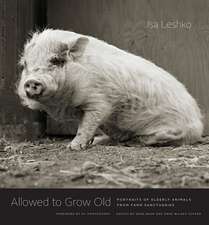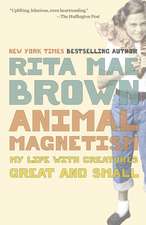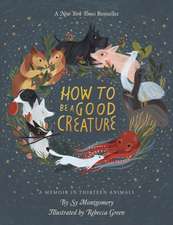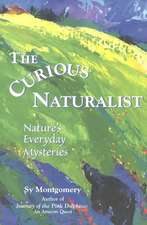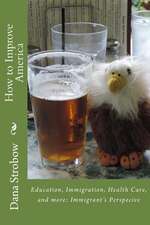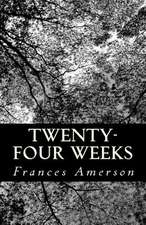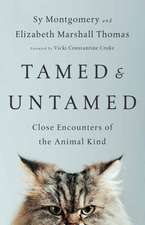The Good Good Pig: The Extraordinary Life of Christopher Hogwood
Autor Sy Montgomeryen Limba Engleză Paperback – 31 mar 2007 – vârsta de la 14 până la 18 ani
–from The Good Good Pig
A naturalist who spent months at a time living on her own among wild creatures in remote jungles, Sy Montgomery had always felt more comfortable with animals than with people. So she gladly opened her heart to a sick piglet who had been crowded away from nourishing meals by his stronger siblings. Yet Sy had no inkling that this piglet, later named Christopher Hogwood, would not only survive but flourish–and she soon found herself engaged with her small-town community in ways she had never dreamed possible. Unexpectedly, Christopher provided this peripatetic traveler with something she had sought all her life: an anchor (eventually weighing 750 pounds) to family and home.
The Good Good Pig celebrates Christopher Hogwood in all his glory, from his inauspicious infancy to hog heaven in rural New Hampshire, where his boundless zest for life and his large, loving heart made him absolute monarch over a (mostly) peaceable kingdom. At first, his domain included only Sy’s cosseted hens and her beautiful border collie, Tess. Then the neighbors began fetching Christopher home from his unauthorized jaunts, the little girls next door started giving him warm, soapy baths, and the villagers brought him delicious leftovers. His intelligence and fame increased along with his girth. He was featured in USA Today and on several National Public Radio environmental programs. On election day, some voters even wrote in Christopher’s name on their ballots.
But as this enchanting book describes, Christopher Hogwood’s influence extended far beyond celebrity; for he was, as a friend said, a great big Buddha master. Sy reveals what she and others learned from this generous soul who just so happened to be a pig–lessons about self-acceptance, the meaning of family, the value of community, and the pleasures of the sweet green Earth. The Good Good Pig provides proof that with love, almost anything is possible.
From the Hardcover edition.
Preț: 94.88 lei
Nou
Puncte Express: 142
Preț estimativ în valută:
18.16€ • 19.73$ • 15.27£
18.16€ • 19.73$ • 15.27£
Carte disponibilă
Livrare economică 31 martie-14 aprilie
Preluare comenzi: 021 569.72.76
Specificații
ISBN-13: 9780345496096
ISBN-10: 0345496094
Pagini: 245
Ilustrații: 8-PAGE 4C INSERT
Dimensiuni: 134 x 203 x 16 mm
Greutate: 0.21 kg
Editura: BALLANTINE BOOKS
ISBN-10: 0345496094
Pagini: 245
Ilustrații: 8-PAGE 4C INSERT
Dimensiuni: 134 x 203 x 16 mm
Greutate: 0.21 kg
Editura: BALLANTINE BOOKS
Recenzii
Advance praise for The Good Good Pig
“This is a book not so much about a barnyard animal as about relationships, in all their messy, joyous, and heartbreaking complexity. In loving yet unsentimental prose, Sy Montgomery captures the richness that animals bring to the human experience. Sometimes it takes a too-smart-for-his-own-good pig to open our eyes to what most matters in life. The Good Good Pig is a good, good book, beautifully rendered and filled with wondrous surprises.”
–John Grogan, author of Marley & Me: Life and Love with the World’s Worst Dog
“I wasn’t sure what to expect when I picked up Sy Montgomery’s story of Christopher the pig. What I found was a charming, touching, funny, and ultimately very powerful tale of an extraordinary, even complicated pig and his impact on some very loving, perceptive, and extraordinary people. This story is heartwarming but packs a wallop.”
–Jon Katz, author of Katz on Dogs
“I love this book! It takes us into the world of one pig with such delicacy, such gentleness and yet such depth, that you will never be able to look a pig in the eye again without recognizing the unique person living within. You become somebody who sees why Sy Montgomery loved a pig beyond all measure.”
–Jeffrey Masson, Ph.D., author of When Elephants Weep
“Move over, Wilbur, there’s a new pig on the block. Sy Montgomery has conjured a pure classic for the animal lover’s soul. Poetic, insightful, funny, and deeply moving, The Good Good Pig is as hard to define as it is to put down. Who else but Sy Montgomery could introduce you to a hog and give you a such glimpse of heaven?”
–Vicki Croke, author of The Lady and the Panda
From the Hardcover edition.
“This is a book not so much about a barnyard animal as about relationships, in all their messy, joyous, and heartbreaking complexity. In loving yet unsentimental prose, Sy Montgomery captures the richness that animals bring to the human experience. Sometimes it takes a too-smart-for-his-own-good pig to open our eyes to what most matters in life. The Good Good Pig is a good, good book, beautifully rendered and filled with wondrous surprises.”
–John Grogan, author of Marley & Me: Life and Love with the World’s Worst Dog
“I wasn’t sure what to expect when I picked up Sy Montgomery’s story of Christopher the pig. What I found was a charming, touching, funny, and ultimately very powerful tale of an extraordinary, even complicated pig and his impact on some very loving, perceptive, and extraordinary people. This story is heartwarming but packs a wallop.”
–Jon Katz, author of Katz on Dogs
“I love this book! It takes us into the world of one pig with such delicacy, such gentleness and yet such depth, that you will never be able to look a pig in the eye again without recognizing the unique person living within. You become somebody who sees why Sy Montgomery loved a pig beyond all measure.”
–Jeffrey Masson, Ph.D., author of When Elephants Weep
“Move over, Wilbur, there’s a new pig on the block. Sy Montgomery has conjured a pure classic for the animal lover’s soul. Poetic, insightful, funny, and deeply moving, The Good Good Pig is as hard to define as it is to put down. Who else but Sy Montgomery could introduce you to a hog and give you a such glimpse of heaven?”
–Vicki Croke, author of The Lady and the Panda
From the Hardcover edition.
Extras
Chapter 1
Runthood
Christopher Hogwood came home on my lap in a shoe box.
On a rain-drenched April evening, so cold the frogs were silent, so gray we could hardly see our barn, my husband drove our rusting Subaru over mud roads sodden with melted snow. Pig manure caked on our boots. The smell of a sick animal hung heavy in our clothes.
It did not seem an auspicious time to make the life- changing choice of adopting a pig.
That whole spring, in fact, had been terrible. My father, an Army general, a hero I so adored that I had confessed in Sunday school that I loved him more than Jesus, was dying painfully, gruesomely of lung cancer. He had survived the Bataan Death March. He had survived three years of Japanese prison camps. In the last months of my father’s life, my glamorous, slender mother—still as crazy about him as the day they’d met forty years before—resisted getting a chairlift, a wheelchair, a hospice nurse. She believed he could survive anything. But he could not survive this.
The only child, I had flown back and forth from New Hampshire to Virginia to be with my parents whenever I could. I would return to New Hampshire from these wrenching trips to try to finish my first book, a tribute to my heroines, primatologists Jane Goodall, Dian Fossey, and Birute Galdikas. The research had been challenging: I had been charged by an angry silverback gorilla in Zaire, stood up by Jane Goodall in Tanzania, undressed by an orangutan in Borneo, and accosted for money by a gun-toting guard ten thousand feet up the side of a volcano in Rwanda. Now I was on a tight deadline, and the words wouldn’t come.
My husband, who writes on American history and preservation, was in the heat of writing his second book. In the Memory House is about time and change in New England, set largely in our corner of the world. But it looked like it might not stay ours for long. For the past three years, ever since our marriage, we had lived, first as renters and then as caretakers, in an idyllic, 110-year-old white clapboard farmhouse on eight acres in southern New Hampshire, near mountains that Thoreau had climbed. Ours was the newest house in our small neighborhood. Though our neighbors owned the two- hundred-year-old “antiques” that real estate agents praised, this place had everything I’d ever wanted: a fenced pasture, a wooded brook, a three-level barn, and forty-year-old lilacs framing the front door. But it was about to be sold out from under us. Our landlords, writer-artist friends our age whose parents had bankrolled the house, had moved to Paris and didn’t plan to come back. We were desperate to buy the place. But because we were both freelance writers, our income was deemed too erratic to merit the mortgage.
It seemed I was about to lose my father, my book, and my home.
But for Christopher Hogwood, the spring had been more terrible yet.
He had been born in mid-February, on a farm owned by George and Mary Iselin, about a thirty-five-minute drive from our house. We knew George and Mary by way of my best friend, Gretchen Vogel. Gretchen knew we had a lot in common. “You’ll love them,” Gretchen had assured me. “They have pigs!”
In fact, George had been raising pigs longer than Mary had known him. “If you’re a farmer or a hippie,” George had reasoned, “you can make money raising pigs.” George and Mary were quintessential hippie farmers: born, as we were, in the 1950s, they lived the ideals of the late ’60s and early ’70s—peace, joy, and love—and, both blessed with radiant blue eyes, blond hair, and good looks, always looked like they had just woken up refreshed from sleeping in a pile of leaves somewhere, perhaps with elves in attendance. They were dedicated back-to-the-landers who lived out of their garden and made their own mayonnaise out of eggs from their free-range hens. They were idealistic, but resourceful, too: it did not escape them that there are vast quantities of free pig food out there, from bakeries, school cafeterias, grocery stores, and factory outlets. George and Mary would get a call to come pick up forty pounds of potato chips or a truckload of Twinkies. To their dismay, they discovered their kids, raised on homemade, organic meals, would sometimes sneak down to the barn at 4 a.m. and eat the junk food they got for the pigs. (“We found out because in the morning we’d find these chocolate rings around their mouths,” Mary told me.)
On their shaggy, overgrown 165 acres, they cut their own firewood, hayed the fields, and raised not only pigs but draft horses, rabbits, ducks, chickens, goats, sheep, and children. But the pigs, I suspect, were George’s favorites. And they were mine, too.
We visited them every spring. We didn’t get to see George and Mary often—our schedules and lives were so different—but the baby pigs ensured we never lost touch. The last time we’d visited was the previous March, at the close of sugaring season, when George was out boiling sap from their sugar maples. March in New Hampshire is the dawn of mud season, and the place looked particularly disheveled. Rusting farm machinery sat stalled, in various states of repair and disrepair, among the mud and wire fencing and melting snow. Colorful, fraying laundry was strung across the front porch like Tibetan prayer flags. Inside the house, an old cottage in desperate need of paint, the floors were coming up and the ceilings were coming down. Late that morning, in a kitchen steamy from the kettle boiling on the woodstove, we found a seemingly uncountable number of small children in flannel pajamas—their three kids plus a number of cousins and visiting friends—sprawled across plates of unfinished pancakes or crawling stickily across the floor. The sink was piled with dirty dishes. As Mary reached for a mug from the pile, she mentioned everyone was just getting over the flu. Would we like a cup of tea?
No thanks, Howard and I answered hastily—but we would like to see the pigs again.
The barn was not Norman Rockwell. It was more like Norman Rockwell meets Edward Hopper. The siding was ancient, the sills rotting, the interior cavernous and furry with cobwebs. We loved it. We would peer over the tall stall doors, our eyes adjusting to the gloom, and find the stalls with piglets in residence. Once we had located a family, we would climb in and play with them.
On some farms, this would be a dangerous proposition. Sows can weigh over five hundred pounds and can snap if they feel their piglets are threatened. The massive jaws can effortlessly crush a peach pit—or a kneecap. The razor-sharp canines strop each other. And for good reason: In the wild, pigs need to be strong and brave. In his hunting days in Brazil, President Theodore Roosevelt once saw a jaguar dismembered by South American native pigs. Although pigs are generally good-natured, more people are killed each year by pigs than by sharks. (Which should be no surprise—how often do you get to see a shark?) Pigs raised on crowded factory farms, tortured into insanity, have been known to eat anything that falls into the pigpen, including the occasional child whose parents are foolish enough to let their kid wander into such a place unsupervised. Feral pigs (of which there are more than four million running around in the United States alone) can kill adult humans if they are threatened. That pigs occasionally eat people has always struck me as only fair, considering the far vaster number of pigs eaten by humans.
But George’s sows were all sweethearts. When we entered a stall, the sow, lying on her side to facilitate nursing, would usually raise her giant, 150-pound head, cast us a benign glance from one intelligent, lash-fringed eye, flex her wondrous and wet nose disk to capture our scent, and utter a grunt of greeting. The piglets were adorable miniatures of their behemoth parents—some pink, some black, some red, some spotted, and some with handsome racing stripes, like baby wild boars, looking like very large chipmunks. At first the piglets seemed unsure whether they should try to eat us or run away. They would rush at us in a herd, squealing, then race back on tiny, high-heeled hooves to their giant, supine mother for another tug on her milky teats. And then they would charge forth again, growing bold enough to chew on shoes or untie laces. Many of the folks who bought a pig from George would later make a point of telling him what a great pig it was. Even though the babies were almost all destined for the freezer, the folks who bought them seldom mentioned what these pigs tasted like as hams or chops or sausage. No, the people would always comment that George’s were particularly nice pigs.
The year Chris was born was a record one for piglets. Because we were beset and frantic, we didn’t visit the barn that February or March. But that year, unknown to us, George and Mary had twenty sows—more than ever before—and almost all of them had record litters.
“Usually a sow doesn’t want to raise more than ten piglets,” Mary explained to me. “Usually a sow has ten good working teats.” (They actually have twelve, but only ten are usually in working order.) When a sow has more than ten piglets, somebody is going to lose out—and that somebody is the runt.
A runt is distinguished not only by its small size and helpless predicament. Unless pulled from the litter and nursed by people, a runt is usually doomed, for it is a threat to the entire pig family. “A runt will make this awful sound—Nynh! Nynh! Nynh!” Mary told me. “It’s just awful. It would attract predators. So the sow’s response is often to bite the runt in half, to stop the noise. But sometimes she can’t tell who’s doing it. She might bite a healthy one, or trample some of the others trying to get to the runt. It isn’t her fault, and you can’t blame her. It screws up the whole litter.”
Every year on the farm, there was a runt or two. George would usually remove the little fellow and bottle-feed it goat milk in the house. With such personalized care, the runt will usually survive. But the class of 1990, with more than two hundred piglets, had no fewer than eighteen runts—so many that George and Mary had to establish a “runt stall” in the barn.
Christopher Hogwood was a runt among runts. He was the smallest of them all—half the size of the other runts. He is a particularly endearing piglet, Mary told us, with enormous ears and black and white spots, and a black patch over one eye like Spuds McKenzie, the bull terrier in the beer commercial. But Mary was convinced he would never survive. It would be more humane to kill him, she urged, than to let him suffer. But George said—as he often does—“Where there’s life, there’s hope.” The little piglet hung on.
But he didn’t grow.
From the Hardcover edition.
Runthood
Christopher Hogwood came home on my lap in a shoe box.
On a rain-drenched April evening, so cold the frogs were silent, so gray we could hardly see our barn, my husband drove our rusting Subaru over mud roads sodden with melted snow. Pig manure caked on our boots. The smell of a sick animal hung heavy in our clothes.
It did not seem an auspicious time to make the life- changing choice of adopting a pig.
That whole spring, in fact, had been terrible. My father, an Army general, a hero I so adored that I had confessed in Sunday school that I loved him more than Jesus, was dying painfully, gruesomely of lung cancer. He had survived the Bataan Death March. He had survived three years of Japanese prison camps. In the last months of my father’s life, my glamorous, slender mother—still as crazy about him as the day they’d met forty years before—resisted getting a chairlift, a wheelchair, a hospice nurse. She believed he could survive anything. But he could not survive this.
The only child, I had flown back and forth from New Hampshire to Virginia to be with my parents whenever I could. I would return to New Hampshire from these wrenching trips to try to finish my first book, a tribute to my heroines, primatologists Jane Goodall, Dian Fossey, and Birute Galdikas. The research had been challenging: I had been charged by an angry silverback gorilla in Zaire, stood up by Jane Goodall in Tanzania, undressed by an orangutan in Borneo, and accosted for money by a gun-toting guard ten thousand feet up the side of a volcano in Rwanda. Now I was on a tight deadline, and the words wouldn’t come.
My husband, who writes on American history and preservation, was in the heat of writing his second book. In the Memory House is about time and change in New England, set largely in our corner of the world. But it looked like it might not stay ours for long. For the past three years, ever since our marriage, we had lived, first as renters and then as caretakers, in an idyllic, 110-year-old white clapboard farmhouse on eight acres in southern New Hampshire, near mountains that Thoreau had climbed. Ours was the newest house in our small neighborhood. Though our neighbors owned the two- hundred-year-old “antiques” that real estate agents praised, this place had everything I’d ever wanted: a fenced pasture, a wooded brook, a three-level barn, and forty-year-old lilacs framing the front door. But it was about to be sold out from under us. Our landlords, writer-artist friends our age whose parents had bankrolled the house, had moved to Paris and didn’t plan to come back. We were desperate to buy the place. But because we were both freelance writers, our income was deemed too erratic to merit the mortgage.
It seemed I was about to lose my father, my book, and my home.
But for Christopher Hogwood, the spring had been more terrible yet.
He had been born in mid-February, on a farm owned by George and Mary Iselin, about a thirty-five-minute drive from our house. We knew George and Mary by way of my best friend, Gretchen Vogel. Gretchen knew we had a lot in common. “You’ll love them,” Gretchen had assured me. “They have pigs!”
In fact, George had been raising pigs longer than Mary had known him. “If you’re a farmer or a hippie,” George had reasoned, “you can make money raising pigs.” George and Mary were quintessential hippie farmers: born, as we were, in the 1950s, they lived the ideals of the late ’60s and early ’70s—peace, joy, and love—and, both blessed with radiant blue eyes, blond hair, and good looks, always looked like they had just woken up refreshed from sleeping in a pile of leaves somewhere, perhaps with elves in attendance. They were dedicated back-to-the-landers who lived out of their garden and made their own mayonnaise out of eggs from their free-range hens. They were idealistic, but resourceful, too: it did not escape them that there are vast quantities of free pig food out there, from bakeries, school cafeterias, grocery stores, and factory outlets. George and Mary would get a call to come pick up forty pounds of potato chips or a truckload of Twinkies. To their dismay, they discovered their kids, raised on homemade, organic meals, would sometimes sneak down to the barn at 4 a.m. and eat the junk food they got for the pigs. (“We found out because in the morning we’d find these chocolate rings around their mouths,” Mary told me.)
On their shaggy, overgrown 165 acres, they cut their own firewood, hayed the fields, and raised not only pigs but draft horses, rabbits, ducks, chickens, goats, sheep, and children. But the pigs, I suspect, were George’s favorites. And they were mine, too.
We visited them every spring. We didn’t get to see George and Mary often—our schedules and lives were so different—but the baby pigs ensured we never lost touch. The last time we’d visited was the previous March, at the close of sugaring season, when George was out boiling sap from their sugar maples. March in New Hampshire is the dawn of mud season, and the place looked particularly disheveled. Rusting farm machinery sat stalled, in various states of repair and disrepair, among the mud and wire fencing and melting snow. Colorful, fraying laundry was strung across the front porch like Tibetan prayer flags. Inside the house, an old cottage in desperate need of paint, the floors were coming up and the ceilings were coming down. Late that morning, in a kitchen steamy from the kettle boiling on the woodstove, we found a seemingly uncountable number of small children in flannel pajamas—their three kids plus a number of cousins and visiting friends—sprawled across plates of unfinished pancakes or crawling stickily across the floor. The sink was piled with dirty dishes. As Mary reached for a mug from the pile, she mentioned everyone was just getting over the flu. Would we like a cup of tea?
No thanks, Howard and I answered hastily—but we would like to see the pigs again.
The barn was not Norman Rockwell. It was more like Norman Rockwell meets Edward Hopper. The siding was ancient, the sills rotting, the interior cavernous and furry with cobwebs. We loved it. We would peer over the tall stall doors, our eyes adjusting to the gloom, and find the stalls with piglets in residence. Once we had located a family, we would climb in and play with them.
On some farms, this would be a dangerous proposition. Sows can weigh over five hundred pounds and can snap if they feel their piglets are threatened. The massive jaws can effortlessly crush a peach pit—or a kneecap. The razor-sharp canines strop each other. And for good reason: In the wild, pigs need to be strong and brave. In his hunting days in Brazil, President Theodore Roosevelt once saw a jaguar dismembered by South American native pigs. Although pigs are generally good-natured, more people are killed each year by pigs than by sharks. (Which should be no surprise—how often do you get to see a shark?) Pigs raised on crowded factory farms, tortured into insanity, have been known to eat anything that falls into the pigpen, including the occasional child whose parents are foolish enough to let their kid wander into such a place unsupervised. Feral pigs (of which there are more than four million running around in the United States alone) can kill adult humans if they are threatened. That pigs occasionally eat people has always struck me as only fair, considering the far vaster number of pigs eaten by humans.
But George’s sows were all sweethearts. When we entered a stall, the sow, lying on her side to facilitate nursing, would usually raise her giant, 150-pound head, cast us a benign glance from one intelligent, lash-fringed eye, flex her wondrous and wet nose disk to capture our scent, and utter a grunt of greeting. The piglets were adorable miniatures of their behemoth parents—some pink, some black, some red, some spotted, and some with handsome racing stripes, like baby wild boars, looking like very large chipmunks. At first the piglets seemed unsure whether they should try to eat us or run away. They would rush at us in a herd, squealing, then race back on tiny, high-heeled hooves to their giant, supine mother for another tug on her milky teats. And then they would charge forth again, growing bold enough to chew on shoes or untie laces. Many of the folks who bought a pig from George would later make a point of telling him what a great pig it was. Even though the babies were almost all destined for the freezer, the folks who bought them seldom mentioned what these pigs tasted like as hams or chops or sausage. No, the people would always comment that George’s were particularly nice pigs.
The year Chris was born was a record one for piglets. Because we were beset and frantic, we didn’t visit the barn that February or March. But that year, unknown to us, George and Mary had twenty sows—more than ever before—and almost all of them had record litters.
“Usually a sow doesn’t want to raise more than ten piglets,” Mary explained to me. “Usually a sow has ten good working teats.” (They actually have twelve, but only ten are usually in working order.) When a sow has more than ten piglets, somebody is going to lose out—and that somebody is the runt.
A runt is distinguished not only by its small size and helpless predicament. Unless pulled from the litter and nursed by people, a runt is usually doomed, for it is a threat to the entire pig family. “A runt will make this awful sound—Nynh! Nynh! Nynh!” Mary told me. “It’s just awful. It would attract predators. So the sow’s response is often to bite the runt in half, to stop the noise. But sometimes she can’t tell who’s doing it. She might bite a healthy one, or trample some of the others trying to get to the runt. It isn’t her fault, and you can’t blame her. It screws up the whole litter.”
Every year on the farm, there was a runt or two. George would usually remove the little fellow and bottle-feed it goat milk in the house. With such personalized care, the runt will usually survive. But the class of 1990, with more than two hundred piglets, had no fewer than eighteen runts—so many that George and Mary had to establish a “runt stall” in the barn.
Christopher Hogwood was a runt among runts. He was the smallest of them all—half the size of the other runts. He is a particularly endearing piglet, Mary told us, with enormous ears and black and white spots, and a black patch over one eye like Spuds McKenzie, the bull terrier in the beer commercial. But Mary was convinced he would never survive. It would be more humane to kill him, she urged, than to let him suffer. But George said—as he often does—“Where there’s life, there’s hope.” The little piglet hung on.
But he didn’t grow.
From the Hardcover edition.
Notă biografică
Sy Montgomery is a naturalist, author, documentary scriptwriter, and radio commentator who writes for children as well as adults. Among her award-winning books are Journey of the Pink Dolphins, Spell of the Tiger, and Search for the Golden Moon Bear. She has made four trips to Peru and Brazil to study the pink dolphins of the Amazon; and on other expeditions, she was chased by an angry silverback gorilla in Zaire; bitten by a vampire bat in Costa Rica; undressed by an orangutan in Borneo; and hunted by a tiger in India. She also worked in a pit crawling with eighteen thousand snakes in Manitoba; handled a wild tarantula in French Guiana; and swam with piranhas, electric eels, and dolphins in the Amazon. She lives in New Hampshire.
From the Hardcover edition.
From the Hardcover edition.
Descriere
This charming memoir chronicles Montgomery's touching friendship with a generous soul, who just so happens to be a pig, and the valuable lessons she learns about family, community, and the pleasures of the sweet, green Earth.


